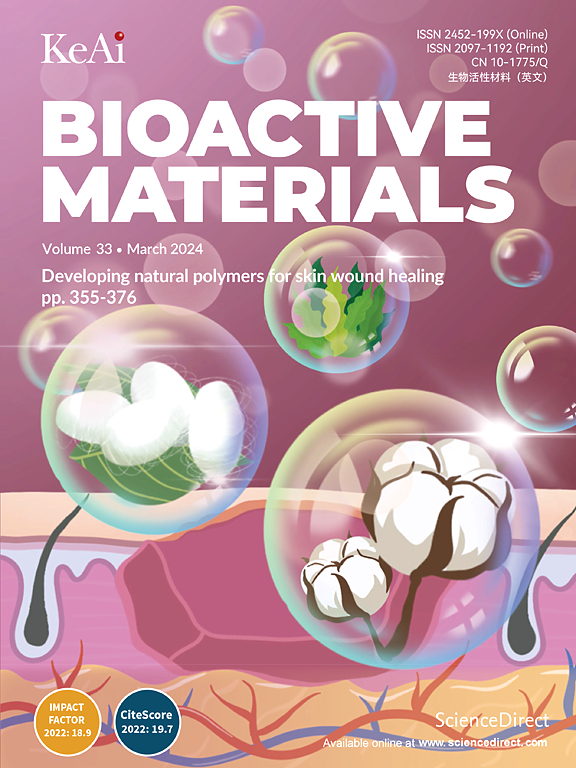3d打印氧化锌纳米颗粒修饰钛酸钡/羟基磷灰石超声响应压电陶瓷复合支架治疗感染性骨缺损。
IF 18
1区 医学
Q1 ENGINEERING, BIOMEDICAL
引用次数: 0
摘要
在临床上,感染性骨缺损是一种严重的威胁,可导致骨坏死,严重影响患者预后,延长住院时间。因此,迫切需要开发一种结合广谱抗菌和骨诱导特性的骨移植替代品,为感染性骨缺损提供一种有效的治疗选择。在本研究中,利用数字光处理(DLP) 3D打印技术的精度构建了一种支架,将氧化锌纳米颗粒(ZnO-NPs)修饰钛酸钡(BT)与羟基磷灰石(HA)结合在一起,制成了一种用于修复感染骨缺损的压电陶瓷支架。结果表明,ZnO-NPs的加入显著改善了BT的压电性能,促进了陶瓷支架系统中HA含量的提高,这对骨再生至关重要。体外抗菌评估突出了支架的有效抗菌能力。此外,结合低强度脉冲超声(LIPUS)和压电的协同作用,结果表明支架具有显著的成骨和血管生成潜力,促进骨生长和修复。此外,转录组学分析结果表明,早期生长反应-1 (EGR1)基因可能在这一过程中起关键作用。本研究介绍了一种在LIPUS联合作用下构建具有良好成骨、血管生成和抗菌性能的压电陶瓷支架的新方法,为感染性骨缺损的治疗提供了一种有前景的治疗策略。本文章由计算机程序翻译,如有差异,请以英文原文为准。

3D-printed zinc oxide nanoparticles modified barium titanate/hydroxyapatite ultrasound-responsive piezoelectric ceramic composite scaffold for treating infected bone defects
Clinically, infectious bone defects represent a significant threat, leading to osteonecrosis, severely compromising patient prognosis, and prolonging hospital stays. Thus, there is an urgent need to develop a bone graft substitute that combines broad-spectrum antibacterial efficacy and bone-inductive properties, providing an effective treatment option for infectious bone defects. In this study, the precision of digital light processing (DLP) 3D printing technology was utilized to construct a scaffold, incorporating zinc oxide nanoparticles (ZnO-NPs) modified barium titanate (BT) with hydroxyapatite (HA), resulting in a piezoelectric ceramic scaffold designed for the repair of infected bone defects. The results indicated that the addition of ZnO-NPs significantly improved the piezoelectric properties of BT, facilitating a higher HA content within the ceramic scaffold system, which is essential for bone regeneration. In vitro antibacterial assessments highlighted the scaffold's potent antibacterial capabilities. Moreover, combining the synergistic effects of low-intensity pulsed ultrasound (LIPUS) and piezoelectricity, results demonstrated that the scaffold promoted notable osteogenic and angiogenic potential, enhancing bone growth and repair. Furthermore, transcriptomics analysis results suggested that the early growth response-1 (EGR1) gene might be crucial in this process. This study introduces a novel method for constructing piezoelectric ceramic scaffolds exhibiting outstanding osteogenic, angiogenic, and antibacterial properties under the combined influence of LIPUS, offering a promising treatment strategy for infectious bone defects.
求助全文
通过发布文献求助,成功后即可免费获取论文全文。
去求助
来源期刊

Bioactive Materials
Biochemistry, Genetics and Molecular Biology-Biotechnology
CiteScore
28.00
自引率
6.30%
发文量
436
审稿时长
20 days
期刊介绍:
Bioactive Materials is a peer-reviewed research publication that focuses on advancements in bioactive materials. The journal accepts research papers, reviews, and rapid communications in the field of next-generation biomaterials that interact with cells, tissues, and organs in various living organisms.
The primary goal of Bioactive Materials is to promote the science and engineering of biomaterials that exhibit adaptiveness to the biological environment. These materials are specifically designed to stimulate or direct appropriate cell and tissue responses or regulate interactions with microorganisms.
The journal covers a wide range of bioactive materials, including those that are engineered or designed in terms of their physical form (e.g. particulate, fiber), topology (e.g. porosity, surface roughness), or dimensions (ranging from macro to nano-scales). Contributions are sought from the following categories of bioactive materials:
Bioactive metals and alloys
Bioactive inorganics: ceramics, glasses, and carbon-based materials
Bioactive polymers and gels
Bioactive materials derived from natural sources
Bioactive composites
These materials find applications in human and veterinary medicine, such as implants, tissue engineering scaffolds, cell/drug/gene carriers, as well as imaging and sensing devices.
 求助内容:
求助内容: 应助结果提醒方式:
应助结果提醒方式:


